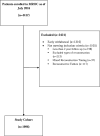Is chronic postsurgical pain surgery-induced? A study of persistent postoperative pain following breast reconstruction
- PMID: 29145033
- PMCID: PMC5742544
- DOI: 10.1016/j.breast.2017.11.001
Is chronic postsurgical pain surgery-induced? A study of persistent postoperative pain following breast reconstruction
Abstract
Background: Chronic postsurgical pain (CPSP) is a reported risk for women undergoing breast reconstruction, but it remains unclear that such persistent pain is induced by reconstructive surgery. To address this concern, this prospective cohort study examined the prevalence of and risk factors associated with CPSP among women undergoing breast reconstruction.
Materials and methods: Women (n = 1996) recruited for the Mastectomy Reconstruction Outcomes Consortium (MROC) Study were assessed preoperatively and at two-years postoperatively for relevant medical/.surgical variables, pain experience, body physical well-being, anxiety, depression, and reconstruction procedure type and characteristics.
Results: Nearly half of the entire sample reported some level of preoperative pain. At two years there were statistically significant but not clinically meaningful increases in both pain intensity and chest/upper body discomfort but a decrease in affective pain rating. Average clinical pain severity was strikingly similar for preoperative and postoperative assessments. Preoperative levels of pain, acute postoperative pain, and (marginally) level of depression held consistent relationship at two-year follow-up with all outcome measures. Autologous flap reconstruction was associated with more severe CPSP compared to TE/I reconstruction. Older age, higher BMI, bilateral reconstruction, and adjuvant radiation and chemotherapy were associated with CPSP and chest/upper body discomfort for at least one outcome measure at two years.
Conclusions: The substantial rate of preoperative pain and comparable prevalence of preoperative and postoperative pain ratings suggest that persistent pain after breast reconstruction may not necessarily reflect surgery-induced pain. Future research will need to determine those factors that contribute to long-term pain following breast reconstruction.
Keywords: BREAST-Q; Breast reconstruction; Chronic postsurgical pain; Depression; MROC, Mastectomy Reconstruction Outcomes Consortium; Mastectomy; Postoperative pain.
Copyright © 2017 Elsevier Ltd. All rights reserved.
Conflict of interest statement
The authors declare no conflict of interest.
Comment in
-
Reconstructive surgery and persistent postsurgical pain after mastectomy.Breast. 2018 Apr;38:188. doi: 10.1016/j.breast.2018.01.009. Epub 2018 Feb 1. Breast. 2018. PMID: 29395982 No abstract available.
References
-
- Kehlet H, Jensen TS, Woolf CJ. Persistent postsurgical pain: risk factors and prevention. Lancet. 2006;367:1618–1625. - PubMed
-
- Lavand’homme P. Transition from acute to chronic pain after surgery. Pain. 2017;158:S50–S54. - PubMed
-
- Andersen KG, Kehlet H. Persistent pain after breast cancer treatment: a critical review of risk factors and strategies for prevention. J Pain. 2011;12:725–746. - PubMed
-
- Vadivelu N, Schreck M, Lopez J, Kodumudi G, Narayan D. Pain after mastectomy and breast reconstruction. Am Surg. 2008;74:285–296. - PubMed
-
- Tsoi B, Ziolkowski NI, Thoma A, Campbell K, O’Reilly D, Goeree BA. Systematic review on the patient-reported outcomes of tissue-expander/implant vs autologous abdominal tissue breast reconstruction in postmastectomy breast cancer patients. J Am Coll Surg. 2014;218:1038–1048. - PubMed
MeSH terms
Grants and funding
LinkOut - more resources
Full Text Sources
Other Literature Sources
Medical


